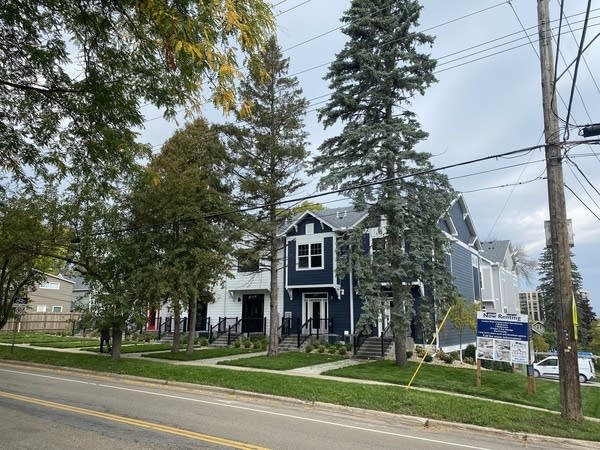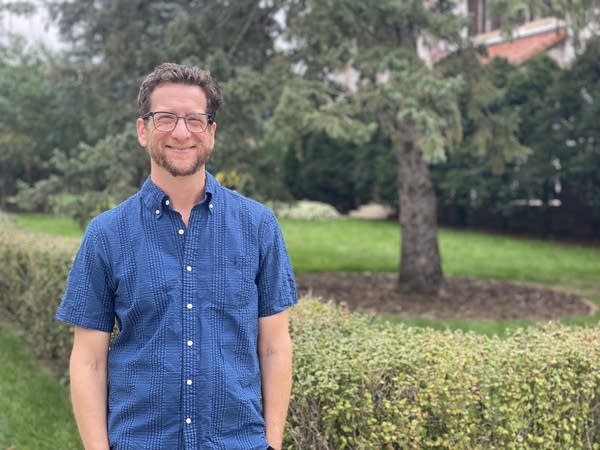As Rochester City Council considers multi-family zoning, Pill Hill pushes back

Go Deeper.
Create an account or log in to save stories.
Like this?
Thanks for liking this story! We have added it to a list of your favorite stories.
As she stands in the front yard of her Pill Hill home, Sasha Gentling describes one of her earliest memories. It happened just down the street, at her grandmother’s home.
“I received my first kitten over at her house. I think I must have been four years old. So I do remember that birthday party in particular,” she said.
This neighborhood of architectural time capsules sits just blocks from Mayo Clinic’s campus. Gentling's family goes back generations in the city — and now, she’s living in her first home around the corner from where her grandparents used to reside.
Recently, Gentling has become an expert on Rochester’s zoning rules because the city wants to allow more multi-family housing here. She’s not opposed to more development in Rochester, but she's worried allowing it in Pill Hill will harm its historic charm.
Turn Up Your Support
MPR News helps you turn down the noise and build shared understanding. Turn up your support for this public resource and keep trusted journalism accessible to all.
“It will change the complexion of this neighborhood a lot sooner than people think,” she said. “If we’re moving to high density from what we know as single family, it doesn’t take that many properties to absolutely change.”
More traffic and lower property values often come up as local concerns, too.
City officials say rezoning neighborhoods close to downtown to allow more multi-family housing is necessary to build Rochester’s housing stock. As it grows under a massive economic development plan called Destination Medical Center, townhomes, apartments and duplexes are in high demand, as is affordable housing.
But the proposed zoning change is also tied to a legacy of housing segregation that historically blocked people of color from certain parts of town.

Property values and housing segregation
City officials argue the zoning changes would be minimal, and only affect parts of the neighborhood.
“The most likely thing to occur is a single family home would be transitioned to a duplex,” said Ryan Yetzer, who works in the city’s Community Development office.
Under the zoning proposal, Yezter said new builds wouldn’t exceed four stories. And even then, there’s not a lot of land in Pill Hill to develop. New construction would require a lot of old homes being sold, torn down and redeveloped.
Based on currently high property values, Yetzer says that’s unlikely. But more housing options in general could make rentals more affordable across the city.
“Housing is expensive because we don’t have enough supply,” he said.

That’s in part because historic practices including single-family housing zoning, redlining and racial covenants segregated Rochester economically and racially decades ago — and made it hard to build denser neighborhoods.
The legacy of all three can be found in Pill Hill, where property values are still among the highest in the city. Previous zoning decisions have allowed multi-family housing in similar downtown neighborhoods, but Yetzer said Pill Hill was excluded.
“What we should be saying is, if the city’s priority is to increase density near downtown, those are the areas that we should rezone. Not ‘Where are the areas that are higher or lower in value,’” he said.
Several years ago, Rochester embarked on an ambitious journey to map every house in the city with a racial covenant — a now illegal tool used across the nation, including in Minnesota, to keep people of color out of white neighborhoods. Some communities used covenants to bar Jews from buying houses in certain neighborhoods.
There where a high concentration of covenants in Rochester’s Pill Hill neighborhood, where doctors that put Mayo Clinic on the map built their homes more than 100 years ago.
But even though such covenants are now illegal — as is redlining, the practice of denying loans based on race — their legacy remains.
Racial covenants tended to enhance the price of a property, said Kirsten Delegard, co-founder of the Mapping Prejudice Project at the University of Minnesota.
“This is something that has persisted even to the current day,” she said. “They tended to provide a green light for investments that drive property values up over time.”
And that contributes to intergenerational wealth, which reinforces the demographics of neighborhoods, said Fernando Burga, who teaches urban planning at the University of Minnesota’s Humphrey School of Public Affairs.
“It’s the idea of being able to own property and pass on the property from generation to generation, and then for that to be resold, and passed on to your children and to your grandchildren — to build a capital asset that you can use in order to thrive,” said Burga. “So racial covenants essentially closed the door for intergenerational wealth to take place for many American citizens.”
Rezoning to allow multi-family housing, which in theory is less expensive, is one tool being deployed in many cities to undo the legacy of housing segregation, said Burga. But the strategy is somewhat untested.
It can lead to new construction, which can bring new people to the neighborhood.

“But it is very hard to say that this has led to this huge demographic shift,” said Burga.
Delegard agrees that creating diverse, more economically equitable neighborhoods requires lots of policies. But she said that neighborhoods that have resisted zoning changes risk becoming stagnant.
“It’s really made it impossible for them to be more dynamic in terms of responding to community needs, whether it’s people needing to downsize, whether it’s young families, older people, people who want more walkable neighborhoods,” she said. “Single-family housing rules really shut off a lot of possibilities for creativity, in terms of the way you think about housing.”
Vibrant communities
Standing on the corner of two main roads that run through Pill Hill, City Council member Mark Bransford said he doesn’t think rezoning will automatically make the neighborhood more racially or economically diverse.
He represents the neighborhood and intends to seek a different solution to the city’s housing shortage, which he doesn’t dispute needs to be addressed.
But he doesn’t buy the idea that tools of housing segregation are entirely to blame for the neighborhood being so much more expensive than other parts of town. He said it would have been the case regardless because of its history and proximity to the first Mayo Clinic buildings.

“Property values here in this area are really high. And they do happen to follow the red lining,” he said. “However, it also could be that this is where all Mayo physicians settled. There’s a lot of Mayo history here. There are other factors involved in why the property values are so high.”
Down the street, homeowner Nick Miller said he’s all for the zoning change.
He and his family moved here just a few years ago from cities where they could walk and bike to work, features that create vibrancy Miller said he wants for everyone considering a move here. Rochester’s future is embedded in attracting more people who want that, he said.
“I have found that in the newer generation of people who are attracted to Rochester, it looks very different than high density car ownership and it looks more like density for people, so that people can be connected to each other.”
Miller said that to him, the zoning debate is ultimately about how many people Rochester is willing to welcome — and where.



